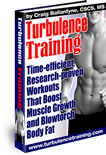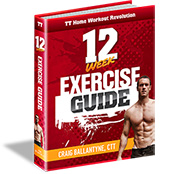Four-Day Training For Building Your Back
 In part 3 we talked about building muscle and getting a lean body like the Men’s Health look. One of the hardest things to do is to figure out your training priority and ways to stick with it.
In part 3 we talked about building muscle and getting a lean body like the Men’s Health look. One of the hardest things to do is to figure out your training priority and ways to stick with it.
Today, I share with how to prioritize your four-day workouts system.
To listen to the call click here.
*****************
Brian: While I have the Turbulence Training genius on the phone, I’m going to be a little selfish for a second. We’re already kind of talking about my body type. I have a question, and I shot you an email about this earlier: How do I get a bigger back?
That is something that I’ve been trying to target and I feel like I’ve been through this program, that program. I’ve trained back once a week and let it rest, I’ve trained twice a week. I feel like I’m at a crossroad. My arms are starting to inflate. I’m starting to get a nice chest coming through. Obviously, my core is still strong, but my back just isn’t budging.
What type of advice would you offer someone like me who has a back trouble spot? You and I both know, people normally don’t work back enough as it is, anyways. What’s some advice you can offer me to kind of blow my back up and get some nice gains, especially in the lat area?
Craig: Well, you’ve got a crazy tattoo on there, as well, so you’ve got to really have a wicked back to show that off.
Brian: Yes, sir.
Craig: I’m going to go back again to a Meatheads-style program. Even before I get to the current spring training one that comes out for March, I’m going to talk a little bit about four-day training protocols. In the past, I tried to put together a lot of four-day. I don’t think you should be training five or six days. In the one study we did, we had guys training six days a week with weights. The problem is you’re going to end up with a shoulder overuse injury, guaranteed, in the long run. You just can’t use the shoulder joint six days in a row, whether you’re squatting or doing many leg exercises, you’re still putting stress on that shoulder area.
Even if you’re doing lower body only, you are stressing the shoulder joint, and obviously in all your upper body stuff. That rules out six days. Five days a week, with the whole body part thing, body building like I did back in high school—it works, but it runs into that same overuse, so I think four times a week is the maximum that I have people lifting.
Even when I started doing these four day a week programs in some of the earlier Meathead workouts, it would be a struggle to really fit in the end of the fourth day. It ended up being more of a three and a half day routine. Jason Peruz and I spoke a lot about that a couple years ago and we were both agreeing that it’s really hard to come up with a four day program.
He’s moved back to some more four day programs, so maybe he’s figured something out that I don’t know, but I still struggle with it and I still think three and a half days at the most.
What we do now in most of the Meathead programs is we stick to generally three days a week. A lot of people think they need more training. In the new program, which I think is great for you, you have a lower body day focused on the squat, and then you have an upper body day where you’re going to get a ton of back work in.
I’m really enjoying these, how many pull ups can I do in eight minutes—sorry, six minutes—that I’ve programmed into some of them? It’s a real great challenge but also gives you great volume and the pull up’s done with great form, as well.
That’s going to be one of your back exercises. I’m really enjoying a wide grip barbell row. That is just a phenomenal exercise for the upper back. Now, also, a one-armed barbell row is one I’ve found on T Nation recently. Everyone listening to this call who likes to lift weights and train their back has probably done a row with a barbell put into the corner between two walls. It comes out at a 45 degree angle.
Most people stand over it and have a V grip on it and do kind of like a T bar row. In this one, you’re just going to stand beside it and do one arm at a time. I’ve found that from John Meadows on T Nation. It’s a great exercise, so we have that one in there too, or regular dumbbell rows.
I do dumbbell rows almost every month. Those are just one of the toughest SOB exercises you’re going to get. Dumbbell rows and split squats in one workout, like I used to put people through in fat loss, those are just nasty, nasty exercises. You’re in that bent over position, it’s just not best for your breathing, and you’re throwing around a lot of weight. That’s a great exercise on so many levels.
Brian: That’s awesome.
Craig: Then, also, dumbbell chest supporter rows, I believe is the fourth back exercise in that upper body day. You’re doing presses, chest supporter rows, then you do the pull ups on their own, then you do the one-armed barbell rows, and then you might do the wide grip rows as well. Man, that is stimulated, it’s not super high in volume once you get through the pull ups, but it’s really great.
Then, later on in the week, a couple days later, you’re doing a dead lift workout, which is obviously going to hit the back as well. On that routine, you’re stimulating the back twice a week with heavy weights, with body weight exercises, a whole bunch of variety in angles and training. That is really a great way that’s going to help you build your back, provided you provide the nutrition for it. You’re going to get great results and I look forward to hearing about your success.
Now, one thing that you’ve got to remember, to go back to that last question that we had, is to prioritize. You’ve got to be able to accept that weight on the scale doesn’t necessarily mean that you’re gaining fat. You’ve got to figure it out. “This is my height, this is my weight right now. Here’s where I want to be.” Five pounds on your frame might not be enough to really have the back. You might need ten, 12 pounds of muscle, which should take you three to four months of training this style.
Don’t worry. Obviously we’ve got tons of great Meathead programs and you’ve got a good metabolism and you’re very active, and you’ve got good nutrition, so you’re not going to gain body fat, and you’re really going to see the results. It will take a little bit of time. I don’t know how well you respond to resistance training, I haven’t really had that discussion with you, but we’ll see. I’ll be very interested to see how many pull ups you’re cranking out in the six minute challenges.
Brian: One day I’ll catch up with Sean . No, I really do enjoy that part of the TT Metabolic Monster Workout he made. You throw in those pull up tabs and I think that’s probably the most I’ve felt my lats in a long time. I mean, it comes down like you said, you do it with the proper technique and you make the pull ups count.
You’re not just going for reps. You make every pull up count and I think that’s what makes the difference, especially with how it burns so well, I guess.
I’ve just got a ton of notes on this call. I hope you guys listening to this call really get a lot from this because I know I did. Is there anything else you want to cover real quick on this call, in terms of body weight training or the Meathead training, or anything like that?
Craig: No. I just want everyone to train this way, to give our training programs a try, and send in your questions. This was a great call. We really did some kind of, not out of the box, but untraditional questions. We really hammered in some good stuff that I don’t get asked all the time and I think that’s why we had such a great call.
Good work, Brian. I appreciate it.
Brian: Hey, thank you. Like I said, I feel all special and warm and fuzzy because I got information from the source. I’m really excited to implement this stuff. I’d like to thank you for phoning in, Craig, and talking along with me on this one. This is more of a personal call towards the end for me, but I know a lot of people out there struggle with the same problem, so thank you so much.
Thanks everyone for listening and we’ll talk to you guys on next week’s podcast. See you later, Craig.
Craig: Thanks.
We’ll talk to you soon, everybody,
Craig Ballantyne, CTT
Certified Turbulence Trainer